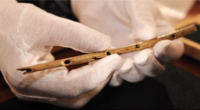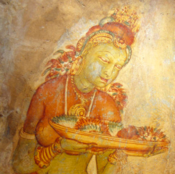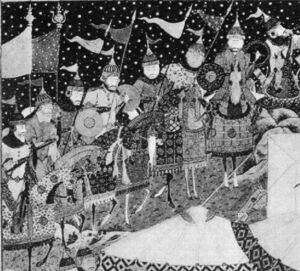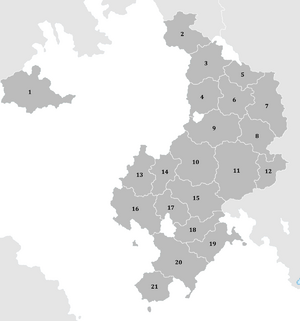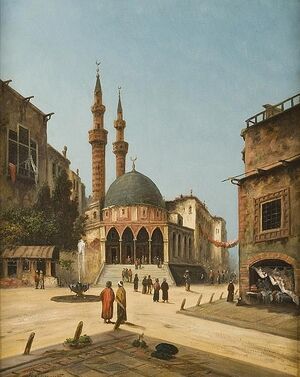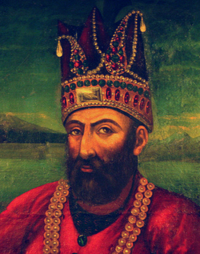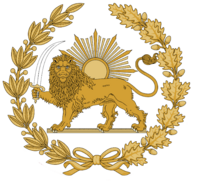Qal'eh: Difference between revisions
No edit summary |
No edit summary |
||
| Line 351: | Line 351: | ||
== See also == | == See also == | ||
[[List of Shahs of Qal'eh]] | [[List of Shahs of Qal'eh]] | ||
{{Template:Qal'eh}} | |||
Revision as of 16:14, 8 May 2019
The Sublime State of Qal'eh دولتی الییه قلعه Dolate Eliyye Qal'eh | |
|---|---|
Motto: بهتر است که امروز به عنوان یک مرد آزاد به عنوان یک برده فرد بمیریم (Persian) Bhetr Aset Keh Amerwez bh 'Enewan ak Merd Azad bh 'Enewan ak Berdh Ferd Bemaram ("Better to die today a free man than tomorrow a slave.") | |
 | |
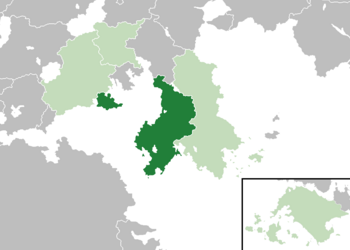 Location of Qal'eh (green) in Western Catai. | |
| Capital | Dahrzor |
| Largest city | Kyderabad |
| Official languages | Qalehi |
| Ethnic groups | 74.2% Qalehis 18.8% Arians 2.2% Uruqs 1.9% Omurans 2.9% Other |
| Religion | State religion: Irsad (Malufi) Recognised minorities: Irsad (Rafada, Muadhi) |
| Demonym(s) | Qalehi |
| Government | Absolute monarchy |
| Ahmad Rouhani | |
| Assembly of Qalehis | |
| Irsadic Assembly of the Peoples of Qal'eh | |
| Establishment | |
• Ardashirvan Empire | c. 476 BC |
• Haydarid Caliphate | c. 606 |
• Khutsog Khanate | c. 902 |
• Assadian Empire | c. 1026 |
• Qalehi Civil War | 1896 - 1901 |
• Monarchy re-established | April 18, 1901 |
• Current constitution | January 21, 1902 |
• 1989 Decree | November 17, 1989 |
| Population | |
• 2013 census | 52,981,727 |
• Density | 39.34/km2 (101.9/sq mi) |
| GDP (nominal) | 2017 estimate |
• Total | $659,728,464,604 |
• Per capita | $12,452 |
| Gini (2015) | high |
| HDI (2015) | very high |
| Currency | Qalehi Zaar (QLZ) |
| Date format | dd-mm-yyyy (official) |
| Driving side | left |
| Calling code | +872 |
| Internet TLD | .ql |
The Sublime State of Qal'eh, commonly known as simply Qal'eh (Qalehi: قله Qāleh [kæleh] is a country in Western Catai. With almost 53 million inhabitants, Qal'eh is the 20th most populous country in Aeia. Comprising a land area of Xkm², Qal'eh is one of the largest nations in its region. It borders Kodesh to the east and Uwhistan to the north.
Qal'eh was first conquered by the expansive Ardashirvan Empire in 476 BC, who destroyed many ancient relics of the tribes of Qal'eh following their conquest, while simultaneously assimilating the culture of the tribesman into a more widely-accepted culture throughout the Empire. Many modern Qalehi traditions can have their roots traced back to the Ardashirvan Empire and the culture of the nation is heavily influenced by the conquest. The region broke away from the Ardashirvan Empire as many small successor states after a mutiny in the 4th century BC caused the army and many minorities within the empire to revolt, eventually leading to its demise. Qal'eh would be plunged into nearly a thousand years of various successor states and small kingdoms until it was conquered by the Haydarid Caliphate around 606 CE. The caliphate introduced Irsad from Hisaristan to Qal'eh. The Caliphate was invaded by Turkic/Mongolic tribes in the 10th century CE, and in 902 the Khutsog Khanate was proclaimed. The Khanate dissolved due to internal instability a hundred years later, and fractured into many successor states. The largest successor state, Assadia, led by Muridin Emir Imrah I, reconquered the shattered realm between 1024 and 1026 in a series of conflicts now known as Imrah's Conquests. Modern-day Qal'eh unified around 200 years after the Assadian Caliphate ceased to exist in 1617, when the three powers in the region agreed to unite into a singular nation under Shahanshah Amin Rouhani, the first of to bear the title in the region for almost a thousand years. Qal'eh would undergo a civil war between monarchists loyal to the Shah and Qalehi republicans, which would end in 1902 and lead to the ratification of the 1902 Constitution, which still holds supreme law in the region. It is a controversial topic in Qal'eh, and its lawfulness is debated due to its age.
The sovereign state of Qal'eh is a minor-to-middle regional power in Catai, and enjoys good relations with its neighbour, Kodesh, mainly due to the fact that both nations follow the Malufi sect of Irsad.
Qal'eh enjoys rich cultural history, with many historic relics of tribes, the Ardashirvan Empire and the Assadian Caliphate adorning the country's museums and displays. The "Qalehi Renaissance" introduced exquisite art to the region, taking on board the techniques of many influential Asuran painters and sculptors.
Etymology
Qal'eh comes from Ardashirvani for "the Summit", supposedly named when one of its Shahs viewed the Iranic Sea from Mt. Asfak.
History
Prehistory
Tribes have walked the lands that are now Qal'eh since around 1500 BC, with evidence of several tools and fossils dating back to that era. Most notably, the Flute of Akhir, which was unearthed in 1997 and named after the town it was found in, has provided some insight into the culture and traditions of early Qalehi tribes.
Ardashirvan Empire
Many scattered nations occupied the land for that time period, but first major conquest came in 476 BC when the Ardashirvan Empire conquered Qal'eh in multiple wars between 481 and 476 BC. Qalehi society gradually became more similar to that of the empire, and for around 400 years, the region was stable. There were some small revolts following the conquest, but none of which posed any threat to the expansive empire. It was around the 4th century BC when major revolts across the empire erupted following a mutiny in the Ardashirvan Empire after the Shah refused to pay their wages, due to an ongoing economic crisis throughout the empire. The crisis, along with the revolts and the mutiny the empire lost control of the region and it was split into several successor states.
Haydarid Caliphate
The Haydarid Caliphate began to pose a major threat to the Qalehi states throughout the 6th century CE, during which time it had conquered most of modern-day Hisaristan and Fahran. The Caliphate invaded in the year 603, claiming all lands it invaded for the Irsad faith and converting many traditional Mazdayasna followers from the times of the Ardashirvan Empire. The conquest was brutal and quick, with the various states not being able to coordinate an organised line of defense against the Caliphate. Many internal conflicts between the states had also left their armies shattered and unable to fight properly. This fact, coupled with Haydarid battle experience from its previous conflicts, ultimately led to the entire Qalehi region being subjugated by late 606. The Haydarid Caliphate began to convert most of the region to Irsad, and the Caliphate is credited with introducing widespread Irsad to Qal'eh from Hisaristan, removing many of the traditional Mazdayasna followers and either banishing or executing followers who refused to convert.
Khutsog Khanate
At the very beginning of the 10th century CE, much of Catai was subject to invasion from Turkic and Mongol tribes from the East, and Qal'eh was not an exception to this. Haydarid power over the region had been waning for a few decades by this point, and in 902 CE the Turkic/Mongol tribes invaded the Caliphate from the east. With the Haydarids not being able to put up much resistance, the war was swift, and later on in the same year the Khutsog Khanate was proclaimed, which covered most of modern day Qal'eh. The Khanate suffered from drastic internal stability problems due to the overwhelming majority Qalehi population, who had different traditions to the Turkic tribes from the east. Many Khutsog leaders were assassinated by Qalehi natives while patrolling cities. The Khanate eventually dissolved and fractured into several more successor states in 1017, and the last of the Turkic tribes were pushed out of the region by 1019.
Assadian Caliphate
One of the successor states, Assadia, controlled most of the lucrative southern coast, and used its large income to not only fund its own army, but also to purchase multiple mercenary armies. Starting in 1024, Emir Imrah I began reconquering most of Qal'eh and uniting it under one banner once again. Due to the devastation the revolts and internal fighting with the Ardashirvan Empire, the states did not put up much resistance, and by 1026 Imrah had conquered all the way back to northern Qal'eh. With such an expansive realm, Imrah proclaimed himself Caliph of Assadia and declared the Assadian Caliphate in late 1026, the Caliphate would go on to have many successful and strong Caliphs after the death of Imrah. The Assadian Caliphate is credited with officially introducing Irsad into the Qalehi realm, with it becoming the official state religion in 1029. The Assadian Caliphate would last some 600 years until, like its predecessor, it suffered major internal revolts and eventually collapsed in 1617. Three states emerged from the revolts, but they would go on to form modern-day Qal'eh in an agreement reached in 1802.
Civil War
A civil war gripped Qal'eh between 1896 and 1901 when republican militias seized much of northern Qal'eh and proclaimed the Irsadic Republic of Arianshahr, the civil war was bloody with hefty losses on both sides, but the monarchist Qal'eh eventually emerged victorious when their forces stormed Dahrzor on April 18, 1901. The day is now celebrated as Liberation Day throughout Qal'eh. Shahanshah Muhammad Nazeri ratified the current constitution of Qal'eh on April 15, 1902. The first large scale Arian revolts happened in 1922 over poor treatment, which lasted four months and affected major cities. The revolt was quelled and relations were salvaged until 1989.
Modern Era
The two major ethnic groups within the nation, Qalehis and Arians, have a tense relationship which has been ongoing for some 30 years (since 1989), when Shahanshah Ahmad Rouhani passed a decree giving native Qalehis priority over Arians over things such as jobs, healthcare and applying for places in the government and military. Several Arian revolts have happened across the 30 year span but so far all have been successfully put down by the Qalehi military.
Geography
Climate
The climate of Qal'eh consists of extremely hot and arid summers in the north and central regions, with little to no rain falling in the regions for most of the year. The southern coast of Qal'eh enjoys cooler summers and winters and more rainfall than its northern and central counterparts, with much of the region being covered in temperate forests, especially on the coasts of the Iranic Sea and Majulan Ocean.
Administrative Divisions
Qal'eh is divided into 21 provinces, each with its own governor personally appointed by the Shahanshah. Most of the more populous provinces, including the capital Dahrzor and largest city Kyderabad, are located in the south of the country.
Qal'eh has a high urban growth rate, with the urban population increasing from 55% to 62% between 2000 and 2017. It is predicted that by 2030, Qalehi urban population will succeed 75%. The country's largest city, Kyderabad, attracts around 150,000 migrants per year, and is an economic and cultural hub of Western Catai.
| Number on map | Province Name | Population | Number on Map | Province Name | Population |
|---|---|---|---|---|---|
| 1 | Kasahgan | 3,762,839 | 12 | Tudasht | 493,277 |
| 2 | Saremeh | 1,873,192 | 13 | Shemrabad | 2,026,883 |
| 3 | Malakeh | 1,916,283 | 14 | Mamdeh | 1,739,288 |
| 4 | Qol-e | 1,581,283 | 15 | Gonbaz | 2,028,772 |
| 5 | Ghazab | 209,812 | 16 | Dahrzor | 6,434,719 |
| 6 | Kashkamir | 972,277 | 17 | Behesht | 2,023,889 |
| 7 | Yadabad | 1,482,662 | 18 | Qujd | 2,273,992 |
| 8 | Pawari | 892,039 | 19 | Kodyan | 3,019,837 |
| 9 | Chah Maku | 2,972,377 | 20 | Kyderabad | 8,980,273 |
| 10 | Tajabad | 3,663,820 | 21 | Zarghari | 2,273,930 |
| 11 | Gur Nasab | 2,360,283 |
Major Cities
Largest cities and towns in Qal'eh
Royal Demographic Institution of Qal'eh | |||||||||
|---|---|---|---|---|---|---|---|---|---|
| Rank | Province | Pop. | Rank | Province | Pop. | ||||
 Kyderabad  Dahrzor |
1 | Kyderabad | Kyderabad | 6,182,038 | 11 | Astari | Chah Maku | 512,938 |  Sahlabad  Sīraf |
| 2 | Dahrzor | Dahrzor | 5,172,928 | 12 | Rezalakh | Kodyan | 497,038 | ||
| 3 | Sahlabad | Tajabad | 1,736,277 | 13 | Chah Kheyr | Yadabad | 461,663 | ||
| 4 | Sīraf | Mamdeh | 977,024 | 14 | Darabad | Kodyan | 382,546 | ||
| 5 | Vardāl | Kasahgan Peninsula | 812,546 | 15 | Posht | Kodyan | 381,377 | ||
| 6 | Arzet | Zarghari | 732,019 | 16 | Habudan | Saremeh | 320,736 | ||
| 7 | Rādez | Shemrabad | 681,564 | 17 | Shahdun | Kyderabad | 282,431 | ||
| 8 | Dashtu | Qol-e | 612,692 | 18 | Chigir | Qujd | 231,290 | ||
| 9 | Senjeru | Malakeh | 604,918 | 19 | Farīmak | Gonbaz | 228,635 | ||
| 10 | Rahimabad | Chah Maku | 540,166 | 20 | Parvaz | Gonbaz | 212,938 | ||
Government and Politics
Qal'eh is an absolute monarchy, and has been since its foundation in 1802. Between 1802 and 1902, the Shahanshah had unlimited power throughout the Qalehi realm. However, after the 1902 constitution was ratified after the Qalehi Civil War, the Shahanshah's powers were somewhat limited.
Shahanshah
The Shahanshah is responsible for supervising (and in some cases, enacting) laws and policies throughout Qal'eh. The Shahanshah holds near-absolute power over the region as outlined in the 1902 Constitution. The Shahanshah also attends major foreign relations events as the representative of Qal'eh, but can assign diplomats in his stead, which is usually the case for smaller foreign visits. The Shahanshah acts as the official head-of-state of Qal'eh and is the Commander of the Qalehi Armed Forces.
Legislature
The legislature of Qal'eh, known as the Irsadic Assembly of the People's of Qal'eh or just the Irsadic Assembly, is a unicameral body consisting of 178 members, who are responsible for drafting laws, debating policies, ratifying treaties and some economic aspects of the country, including the annual budget. The Irsadic Assembly is also responsible for drafting amendments to the constitution. All laws that exit the Irsadic Assembly must be ratified by the Shahanshah. All candidates for the Irsadic Assembly require approval from the Assembly of Qalehis.

The Assembly of Qalehis consists of 10 field-specific experts, all appointed by the Shahanshah. The Assembly of Qalehis is responsible for interpreting the Constitution, and scrutinising laws passed by the Irsadic Assembly. If a law is deemed incompatible with the Consitution or the Iqar (Irsadic law), it is sent back to the Irsadic Assembly for revision. The Assembly of Qalehis is also responsible for supervising passed amendments to the 1902 Constitution, the last of which was in 1998. The Assembly of Qalehis may ignore amendments that failed to receive majority vote in the Irsadic Assembly, and must implement amendments that received over 95% of votes. The Assembly of Qalehis ultimately have the final decision if the amendment carried a majority of less than 95%.
Law
The Assembly of Qalehis appoint the Judiciary under the supervision of the Shahanshah. Court rulings can be appealed to the Assembly of Qalehis, although the legitimacy and impartiality of this appeal process is debated. Qalehi law comprises Iqar Law and other laws specific to the region. The Shahanshah may enact Royal Decrees with the consent of the Assembly of Qalehis, which have the full force of law. One notorious example is the 1989 Decree, which causes political turmoil in Qal'eh to this day.
Foreign Relations
Qalehi relations with most of Western Catai are stable, and the nation enjoys good relations with its neighbour, Kodesh, both of whom are Malufi absolute monarchies.
Military
Qal'eh has three branches that make up its military forces, the Army, Navy and Air Force. The Qalehi Armed Forces are made up 257,500 active troops, 71,000 of which are conscripts, and 391,000 reserve troops, totalling just under 650,000 trained troops.
Qal'eh spends just under $12 billion on its military, totalling 1.8% of its GDP or $225 per capita.
Economy
Agriculture
Much of the southern portion of Qal'eh consists of fertile and arable land, most notably in the Dahrzor and Kyderabad regions, where the two largest cities are located. The southern coast of Qal'eh is home to a number of exotic fruits, including a staple in Qalehi cuisine, the fig. While the northern portion of the country is mainly desert in the inland, the coastal regions are suitable for farming. As such, the government is investing in getting the northern regions up to par in terms of agriculture, with around $650 million invested for it in a plan announced in 2016.
Industry
The industrial heartlands of Qal'eh are also in the southern region of the country, with many of the country's larger cities being in the south due to industrial migration. Qalehi companies export and have operations in many Western Catai countries, with this only increasing after Qal'eh signed the Kizilkand Agreements in 1997.
Qal'eh has many automobile manufacturing companies, although most only work domestically. The capital province of Dahrzor contained around 40% of the country's industry in 2015, mainly private military industry selling equipment to the Qalehi Armed Forces. The industrial sector of Qal'eh employed around 37% of the population in the 2013 census and industry contributes to around 75% of the Qalehi GDP.
Natural Resources
Qal'eh is one of the largest natural gas and oil exporters in Western Catai, and much of the nation is powered by the two resources. Large fracking operations take place in the north-east of Qal'eh, where a large proven natural gas reserve was recently discovered, whereas oil extraction takes place mainly in the central regions of Qal'eh.
Education, science and technology
Qal'eh has a secondary school enrollment rate of over 99%, and attending school until 17 is enforced by the law. However this age is reduced to 16 if the student joins the military. Many prestigious universities in Qal'eh attract students from all over Western Catai, such as the Royal University of Kodyan. Qalehi levels of education are split into three fields, a secondary degree (derjh dewm), which is attained upon leaving high school at 17, a bachelor's degree (medrek keareshenasa), which is achieved for completing an undergraduate course and passing the undergraduate exam at a Qalehi university, and a master's degree (medrek keareshenasa areshed; also known as derjh nekhebguan) received upon completing the postgraduate course and passing the postgraduate exam at a Qalehi university. A master's degree is required to persue a doctorate (deketera) in Qal'eh.
The Qalehi science sector is not very large, and Qal'eh itself has not been responsible for many innovations throughout the 19th and 20th centuries. Many ancient inventions of the Ardashirvan Empire and the Assadian Caliphate were invented within Qal'eh, but they are often attributed to the empires themselves, rather than where they were made. Recently, however, Qal'eh has become an emergent nation in the fields of stem cell research and nanotechnology, with stem cell operations already present in many Qalehi hospitals and surgeries.
Demographics
| 1943-2013 | ||
|---|---|---|
| Year | Pop. | ±% p.a. |
| 1943 | 6,827,910 | — |
| 1953 | 12,637,982 | +6.35% |
| 1963 | 19,829,390 | +4.61% |
| 1973 | 25,729,993 | +2.64% |
| 1983 | 30,523,413 | +1.72% |
| 1993 | 36,720,188 | +1.87% |
| 2003 | 44,341,882 | +1.90% |
| 2013 | 52,981,727 | +1.80% |
Qal'eh is home to many differing ethnic groups, who are united under a shared Qalehi identity. The population of Qal'eh was 52,981,727 at the 2013 census, 74% of whom identified as Qalehi. Net migration has plateaued at around 310,000 for the past two decades, reaching its peak of 317,000 in 1999. Qal'eh is the 4th most populous country in Western Catai, falling behind Dayganistan (80 million), Kodesh (78.6 million) and Hisaristan (58.2 million). The population density of Qal'eh is Xkm² (Xmi²), with the population density being highest in Dahrzor and Kyderabad.
Languages
Qalehi is the main language of Qal'eh, with over 95% of the populace speaking it. Other languages are spoken throughout Qal'eh, including many minority dialects, but these other languages and dialects are often suppressed during education, as Qalehi is the only language taught in the curriculum. Due to this, the number of foreign language speakers in Qal'eh is declining.
Ethnic Groups
Ethnic Groups in Qal'eh (2016 est.)
Qal'eh is technically a very diverse region, but most of these differing minorities identify as Qalehi when asked. Qalehis are believed to be descended from the peoples of the Ardashirvan Empire, with many Qalehis also having ancestry from Eastern Catai from when the Khutsog Khanate ruled the region.
Ethnicites within Qal'eh remain a point of debate, with the omission of an ethnicity section in every census since 1993, ethnic boundaries and populations within the country are educated estimates. The general consensus is that around 74-75% are of Qalehi ethnicity and a further 15-20% are of Arian ethnicity. Minorities from other ethno-linguistic backgrounds include Omurans from Kodesh and Uruqs from Uwhistan. Other minor ethnicities in Qal'eh make up around 3% of the population, which include people from Asuran background, as well as East and Far West Cataians.
The Royal Qalehi Demographics Institution, the branch of government tasked with arranging and estimating the demographics of the nation, estimate that some 90% of Qal'eh are of Qalehi background, but this estimate is widely believed by demographic experts to be biased and inaccurate.
Religion
Malufi Irsad is the official state religion, the status of which is widely enforced and influences important structures of Qalehi soceity such as law and the educational curriculum (Irsadic values are taught to children when they begin education). Under Qalehi law it is illegal to practice other religions in public, with the construction of other holy buildings such as churches forbidden. Qal'eh generally has a poor human rights record when it comes to religion.
In the 2013 census, around 95% of Qalehi citizens answered that they were Malufi Murudin, with the other 5% consisting of Rafada and Muadhi Muridin. The high majority of Muridin in Qal'eh make it one of the most religious nations in Aeia. Many Qalehi Muridin attend mosque services, with an estimated 25 million Qalehis visiting a mosque within the country daily.
Culture
Art
Qalehi art has a rich history, dating back to ancient tribal cave paintings in central Qal'eh, discovered some time in the 19th century, known as the Chigir Cave Paintings, named after the city they reside near. They are believed to have been painted around 1500 - 1000 BC, with some historians and art experts estimating they could even be as old as 2000 BC.
Qalehi art developed further while it was under the rule of the Ardashirvan Empire, and many detailed paintings of landscapes and portraits for its time emerged during this period. Qalehi art remained unchanged for a long period of time after Ardashirvan painting traditions were introduced. When Irsad was introduced into the region by the Haydarid Caliphate, many paintings of Allah and historic Irsadic figures such as Mubashir emerged, and Qalehi Irsadic paintings would continue to be produced throughout the era.
Throughout the 18th and 19th centuries, large changes in how Qalehi artists and sculptors made their work occurred. Largely influenced by their Asuran equivalents, new techniques of painting, as well as new topics of paintings, started circulating around Qal'eh. The period of time has come to be known as the "Qalehi Renaissance". The Qalehi Renaissance also introduced marble into the Qalehi sculpting world. The first known work of the Qalehi Renaissance was a painting entitled Zommari Mosque, by Taqi al-Jafir, an influential Qalehi Renaissance artist, which was painted in either 1771 or 1772.
Since then, Qalehi art has been at the forefront of West Cataian culture, and many influential historical leaders of Catai have chosen to have portraits painted by Qalehi artists. The Dahrzor Art Exhibition showcases art from all over Qal'eh, and convenes annually at the Omid Yazdan Centre in Dahrzor.
Architecture
Qalehi architecture is similar to its West Cataian counterparts, with many grand mosques adorning the landscape of Qal'eh. The two most famous mosques, the Zommari Mosque and Grand Mosque, both in Dahrzor, attract around 5 million worshippers per year.
The history of Qalehi architecture can be traced back to the Ardashirvan Empire, where many basic shrines and temples were constructed for the Mazdayasna faith of the empire. These temples were often constructed using rock and sandstone, and some of these holy sites still exist today, mainly in the southern coast of Qal'eh. The architecture in Qal'eh varies depending on the era it was built in. Obvious differences between pre and post-Irsadic architecture can be seen in many older buildings.
Evidence that mathematics and geometry were used in Qalehi architecture can be found from the Ardashirvan Empire, making it one of the first nations to do so. Some art experts in Qal'eh argue that its architecture is its proudest form of art.
Literature
The oldest evidence of Qalehi literature is an ancient transcription of the Mazdayasna holy text, the Avesta, found near the city of Kyderabad in an archaeological dig in the 1940s. The transcription of the text is said to date as far back as 200 BC, and was likely to have been used in many Mazdayasna ceremonies in southern Qal'eh. The author of the transcription is unknown, but it is widely agreed upon by historians to be the work of a Mazdayasnan cleric named Kiarash Tut, who was extremely influential in the religion of the region at the time.
Since then, many transcriptions of the Irsadic holy text, the Nashwad, have been transcribed in Qal'eh. Many old transcriptions from when the first Irsadic conquests occurred in around the 7th century still exist in museums around Qal'eh.
Modern Qalehi literature is somewhat stagnant, with no real influential non-religious literature originating in the nation. Qal'eh holds an annual literary festival in Chigir, in which domestic authors can come together to share and advertise their writing.
Philosophy
Zartosht, The Thesis of Religion
Qalehi has a rich history of philosophy and philosophical thought. The ancient Qalehi philosopher and prophet Zartosht (born c. 412 BC) introduced a wide range of philosophical thought into Qalehi (and Ardashirvan) society. He preached many widely accepted modern values today including religious tolerance and freedom of speech, and wrote many books on his thoughts. The most notorious of which, The Thesis of Religion, published around 385-370 BC, first introduced the ideas of religious tolerance and religious freedoms into mainstream Qalehi society. The original copy of Zartosht's Thesis is kept in the Royal Library of Dahrzor, where it continues to influence many modern philosophers around Aeia. Zartosht was also an avid follower of Mazdayasna, and regularly attended religious ceremonies and festivals.
Music
Qalehi music has existed since the 2nd century BC, where many early wind and string instruments were first developed and used. Zoroaster's Hymn is a famous piece of music composed around 50 BC which utilises many of these ancient wind and string instruments.
The music of Qal'eh began to develop drastically after the Irsadic conqeusts of the Haydarids in the 7th century and even more so after Imrah's Conquests stopped in 1026. Many developments in musical writing, notations and playing occurred in the early Irsadic times of Qal'eh. The nation's traditional folk music, Korab, originated in the 11th century, and is said to have been played to Sultan Imrah in Dashtu at a ceremony celebrating his conquests. Korab is still widely used today, and is played at many important events, including coronations, funerals and official diplomatic visits.
Observances
Public Holidays
Liberation Day is celebrated on April 18 to commemorate the royalist forces storming the gates of Dahrzor, the last republican stronghold, and ending the Qalehi Civil War.
Cuisine
Qalehi cuisine is very diverse due to the large number of differing ethnic groups and cultures within its borders. Many aspects of Qalehi cuisine make use of the fig, a national staple and widely grown fruit on the south coast. Many Qalehi patisseries are renowned for their fig jams. Tea is widely consumed in Qal'eh and is usually the focal point of many small meals.
Other staple Qalehi cuisines include falafel, stews and soups, kebabs and yoghurts.
Sports
The population of Qal'eh is quite young, and as such, many people in Qal'eh participate in an organised sport.
The most widely-played sport in Qal'eh is football with around a million active players in the country. The Qalehi National League is the nation's top-tier football league. Basketball is also extremely popular in Qal'eh, and the men's national team is extremely successful in international basketball exhibition matches.
The Royal Sporting Committee of Qal'eh was formed in 1967 and aimed to consolidate the many small sporting organisations of Qal'eh into one central organisation. The RSCQ is responsible for organising Qalehi athletes' participation in international sporting events, as well as acting as a central governing body for most Qalehi sport.
Media
Qal'eh has poor press freedoms, with political dissidents and anti-Irsadic journalists and reporters being arrested and censored on numerous occasions. The government of Qal'eh is also known to apprehend many journalists who speak out against the government, with some never returning (assumed to have been killed).
The Royal Press Society regulates all press and media within Qal'eh, including TV news as well as magazines and newspapers. The first iterations of newspapers were circulated during the reign of Mohammed Mohsen Rouhani, when the Irsadic Qalehi Herald was introduced as the country's national newspaper in 1877. The IQH continues to be Qal'eh's largest newspaper printer and publisher.
Television in Qal'eh was introduced in 1961, and full colour broadcasts began in 1980. The National Broadcasting Service (NBS) has influence over most Qalehi radio, television and press. The NBS has been accused on numerous occasions of corruption and governmental meddling. It is almost certain that the NBS has ties to the government and the Shahanshah.


